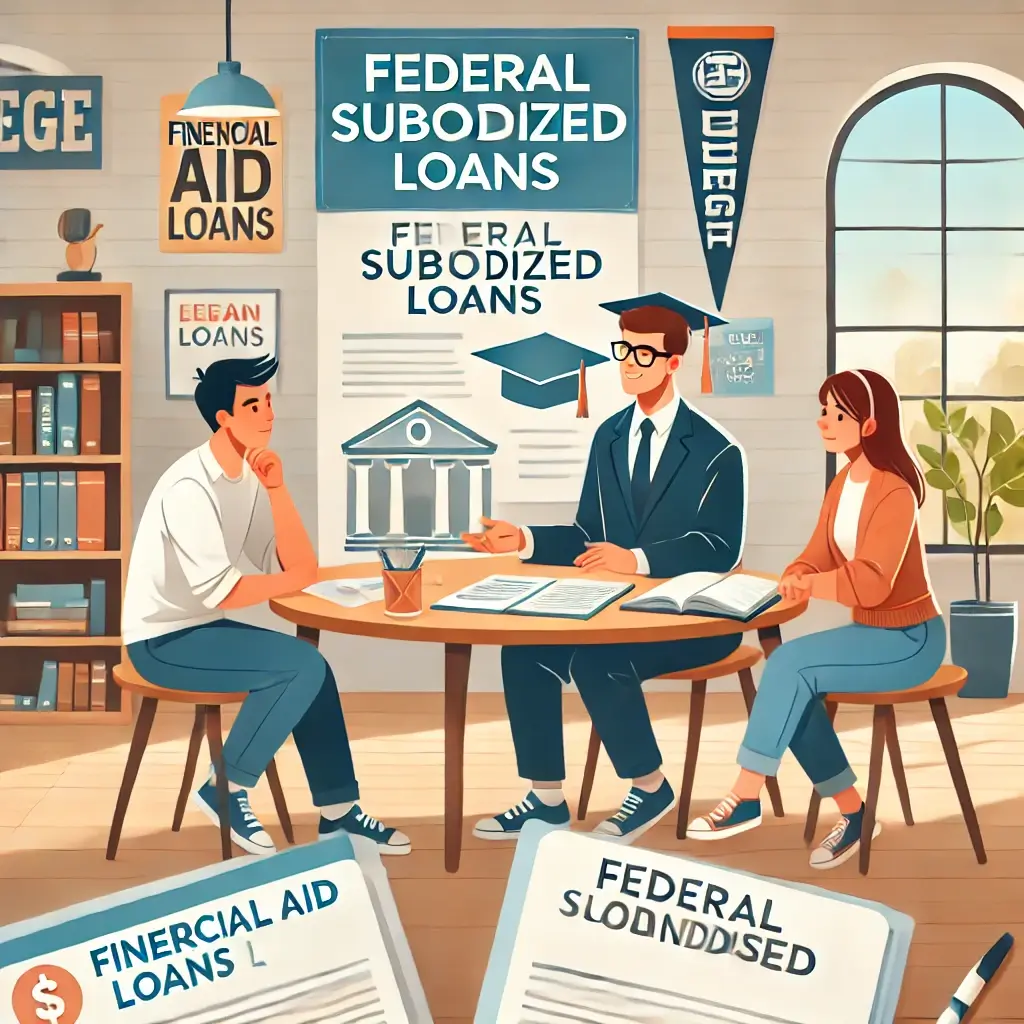Federal Subsidized Loans are a valuable financial resource for students with demonstrated financial need, helping them access higher education by covering essential expenses like tuition, housing, and supplies. These loans are part of the William D. Ford Federal Direct Loan Program and are designed specifically to support eligible students in overcoming financial barriers to their education. A key benefit of Federal Subsidized Loans is that they do not accrue interest while the student is in school, during the grace period, or in deferment. This unique feature makes them a more affordable option compared to other loan types.
These Subsidized Loans aim to make higher education accessible and financially manageable. They offer favorable terms and low interest rates, calculated based on a student’s financial need through the Free Application for Federal Student Aid (FAFSA). By understanding the eligibility criteria, interest benefits, and repayment options of these loans, students can make informed decisions about their financial future.
Eligibility Criteria for Federal Subsidized Loans
To qualify for Federal Subsidized Loans, students must demonstrate financial need, assessed through several key factors:
Financial Need and FAFSA
Financial need is determined through the FAFSA, which evaluates a family’s financial standing, including income and assets. The Expected Family Contribution (EFC) calculated by FAFSA plays a central role in determining eligibility; students with lower EFCs are prioritized for Federal Subsidized Loans.
Enrollment Status
Students must be enrolled at least half-time in a qualifying program at a participating institution to be eligible for subsidized loans. Full-time enrollment may increase financial assistance, but half-time students are also eligible for support.
Academic Progress
Maintaining satisfactory academic progress is also essential for continued eligibility. This includes meeting a minimum GPA and completing a required number of credits per term. Failure to meet these academic standards may result in the loss of eligibility.
Meeting these criteria allows students to benefit from Subsidized Loans, giving them access to essential financial support throughout their education.
How Federal Subsidized Loans Work
Federal Subsidized Loans provide significant benefits that make them particularly appealing to students with financial need:
- Interest Subsidies: While the student is in school at least half-time, the federal government pays the interest on these loans. This benefit continues during the six-month grace period after graduation and any approved deferment periods, effectively reducing the overall debt burden.
- Loan Amount Limits: Loan limits vary by the student’s year in school and dependency status. For instance, undergraduate students may borrow between $3,500 and $5,500 per year, with a cumulative limit of $23,000 for dependent students and $57,500 for independent students.
- Application Process: To apply for subsidized loans, students must complete the FAFSA, which collects critical financial information for evaluating aid eligibility. Approved students receive a financial aid package, outlining the types and amounts of aid they qualify for, including potential Federal Subsidized Loans.
Federal Subsidized Loans disburse funds directly to the school, covering tuition and other fees. Any remaining balance is provided to the student for additional educational expenses, such as books or housing.
Interest Benefits of Federal Subsidized Loans
One of the defining benefits of Federal Subsidized Loans is their interest subsidy, which can lead to substantial savings over time. Here’s how these interest benefits work:
- In-School Subsidy: The government covers the interest while the student is enrolled at least half-time. This ensures that the loan balance remains the same until graduation, unlike unsubsidized loans, where interest accrues immediately.
- Grace Period: After graduation or when a student drops below half-time enrollment, there’s a six-month grace period during which interest is still covered by the government, allowing time to establish a stable income before payments begin.
- Deferment: In times of financial hardship, eligible borrowers may defer loan payments without accruing interest. This feature provides essential financial relief and prevents debt from growing during challenging periods.
The interest subsidies associated with Federal Subsidized Loans make them a highly affordable option for students, significantly reducing the total cost of borrowing.
Comparison with Other Federal Loan Types
Understanding how Federal Subsidized Loans differ from other federal loans can help students make informed financial choices:
Federal Unsubsidized Loans
Unlike subsidized loans, unsubsidized federal loans do not have interest coverage benefits. Interest begins to accrue from the disbursement date, increasing the total debt by graduation. Unsubsidized loans are available to all eligible students regardless of financial need.
PLUS Loans
Parent PLUS Loans are available to parents of dependent students and cover the remaining cost of attendance after other financial aid is applied. These loans require a credit check, come with higher interest rates, and do not include an interest subsidy. They may also be used by graduate students.
The main distinction lies in the interest benefits and eligibility requirements; Federal Subsidized Loans are designed specifically for undergraduate students with financial need, while other federal loan types serve broader purposes and have varied terms.

Repayment Options for Federal Subsidized Loans
Upon graduation, managing repayment for Federal Subsidized Loans is essential. Several repayment options are available to help borrowers meet their obligations based on their financial situation:
Standard Repayment Plan
Under the standard plan, borrowers make fixed monthly payments over 10 years. This plan minimizes the total interest paid over time and is suitable for those who can afford consistent payments.
Income-Driven Repayment (IDR) Plans
Income-driven plans adjust monthly payments based on the borrower’s income and family size. These plans extend the repayment term to 20 or 25 years, and any remaining balance may be forgiven after this period. IDR plans provide flexibility for those with variable income or limited financial resources.
Public Service Loan Forgiveness (PSLF)
Borrowers working in qualifying public service jobs may be eligible for PSLF, where the remaining loan balance is forgiven after 120 qualifying payments. This option is particularly beneficial for those committed to careers in education, healthcare, or non-profits.
By exploring these repayment options, borrowers can choose a strategy that aligns with their financial goals and minimizes the impact of loan repayment on their budget.
Financial Planning with Federal Subsidized Loans
Federal Subsidized Loans are an essential component of financial planning for students with limited resources. Their low-interest and interest-free in-school benefits enable students to focus on their studies without accruing excessive debt. Here’s how subsidized loans impact financial planning:
- Budgeting During School: The absence of in-school interest allows students to create a budget without worrying about accumulating debt. Students can use any remaining loan funds for essential expenses and prioritize smart financial habits.
- Long-Term Financial Health: Lower debt levels upon graduation allow students to plan for future financial goals, such as buying a home or saving for retirement. Graduates with manageable debt can pursue careers that align with their interests, rather than solely focusing on income for loan repayment.
- Funding Education Alongside Scholarships: While subsidized loans can be a primary funding source, students should also explore scholarships, grants, and part-time work to supplement their finances and further reduce reliance on loans.
Federal Subsidized Loans provide a foundation that supports both immediate educational needs and long-term financial stability, empowering students to pursue higher education without overwhelming debt.
Common Myths About Federal Subsidized Loans
Misunderstandings about Federal Subsidized Loans can lead to unnecessary confusion. Here are some common Student loan myths debunked:
- Myth: Subsidized Loans Are Hard to Qualify For
Fact: These loans are accessible to undergraduate students with demonstrated financial need, determined through FAFSA. - Myth: Subsidized Loans Have High Interest Rates
Fact: Interest rates for federally subsidized loans are generally lower and fixed, offering affordable repayment options. - Myth: Defaulting on Loans Is Unmanageable
Fact: Federal loans come with flexible repayment options like income-driven plans and deferment, providing relief in times of financial difficulty.
By understanding these realities, students can make confident, informed decisions about financing their education with Federal Subsidized Loans.
Resources for Further Assistance
Navigating Federal Subsidized Loans can be complex, but many resources are available to guide students:
- Federal Student Aid Website: The official site provides detailed information on federal loans, eligibility, and repayment options.
- School Financial Aid Offices: Financial aid advisors can offer personalized assistance with FAFSA, eligibility questions, and loan management.
- Non-Profit Organizations: Resources like the Consumer Financial Protection Bureau (CFPB) provide valuable guidance on budgeting and student loan management.
- Workshops and Webinars: Many colleges host sessions on financial literacy and managing student loans, which can be invaluable for understanding the loan process.
Accessing these resources can help students effectively manage Subsidized Loans and make well-informed decisions about their educational financing.
With a solid understanding of Federal Subsidized Loans, students can confidently pursue higher education while managing their financial future responsibly. This loan option provides significant financial relief, allowing students to focus on their studies without the worry of mounting debt, thus creating a stronger foundation for post-graduation success.
